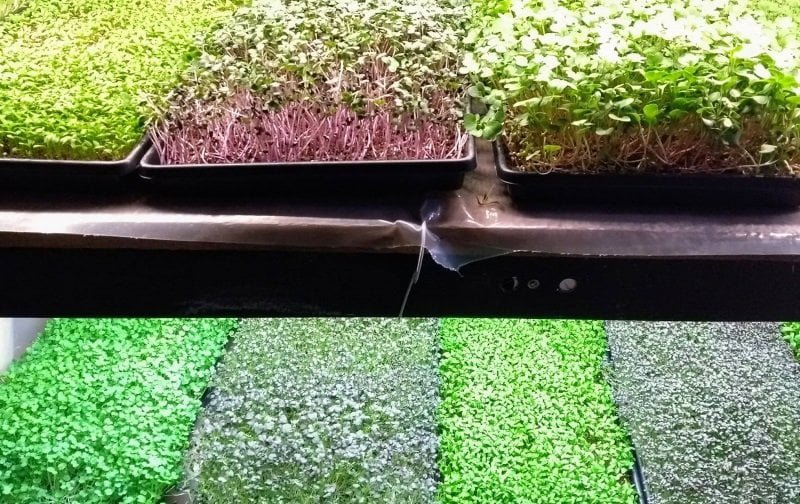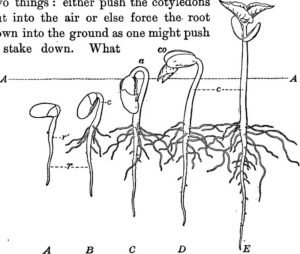You may be asking yourself why on earth you would ever want to grow microgreens. These tiny plants must be grown in many multiples just to barely fill your plate. Why bother with microgreens then when you can grow the full version? There must be something to this microgreen trend….
As a matter of fact, there is! Microgreens have become a trendy and nutritious counterpart to their grown versions for many reasons. Not only do they add bold flavors and color to the plate, they also pack additional powerful nutrients. Some folks are even making a pretty darn good living growing and selling microgreens to restaurants.
If you have been curious about growing microgreens but have been unsure where to start, you have landed in the right place. I have researched and written this extensive guide to help you get going on growing microgreens, no matter what space you have. Let’s get this (tiny) party started!

Intro into Microgreens
What are Microgreens? A microgreen is your typical salad type vegetable that comes in a mini size. In order to achieve the miniature version, the microgreen is picked just after the first leaves have sprouted and developed. This makes for a super tender and highly flavorful green that is packed with nutrients.
Microgreens have become a popular trend in the past couple of decades as a flavor enhancer and garnish for chefs in fine dining restaurants. You may also find microgreens popping up among the booths at a farmer’s market – both these elements make growing microgreens a potentially lucrative endeavor.
A microgreen doesn’t just have to be of the salad variety; you can grow grains and herbs into micros as well.
Benefits of Microgreens
Mature greens are already super nutritious for you, but studies have shown that certain – but not all – microgreens can pack a higher nutritional punch than their mature counterparts.
The University of Maryland’s Department of Nutrition and Food Science did a thorough study in 2012 to test for the nutrient densities in microgreens in relation to mature greens.
The plant scientists studied 25 common microgreens for tocopherols, phylloquinone, carotenoids, and ascorbic acid concentrations. Although the results found that the results varied greatly between the greens, four forerunners stood out: Green Daikon Radish, Garnet Amaranth, Cilantro, and Red Cabbage all had the highest concentrations of aforementioned nutrients.
Aside from their punchy health benefits, these tiny greens are deliciously intense, have a crisp texture, and offer up a colorful accent to the plate.
As far as farming goes, microgreens grow quickly; the little guys are ready for harvest between 16 to 25 days, and some can be harvested as early as 8 days.
They do not require much room to grow and can even be grown in jars!
Best Types of Microgreens
There is a plethora of edible plants that can be cultivated into microgreens. So which ones are the best ones to grow? This is somewhat of a loaded question because the type you choose to grow depends on your intent. These intentions could be the choosing healthiest, most nutritious green. You might be growing for the fastest results, or you could be planning to sell your greens, therefore choosing the most popular and profitable green is critical. Based on these grounds, the greens that check all the aforementioned boxes would technically be the “best” greens to grow.
Healthiest microgreens
Identifying the healthiest microgreens is subjective as all greens are healthy! I hand picked these ones out of a large variety because they are known to have even more nutrients than their adult counterparts, offer the entire body a health boost, and are common to find.
As mentioned above, the top 4 microgreens for an additional nutrient boost:
Green Daikon Radish – high in vitamin C, fibrous, rich in potassium, phosphorous, digestive enzymes
Garnet Amaranth – offers up calcium, lysine, antioxidants, high in protein
Cilantro – detoxification from metals, phytochemicals, potassium, zinc, iron, magnesium
Red Cabbage – thiamin, riboflavin, folate, iron, magnesium, calcium

Red Cabbage in the microgreen phase
Some notable micros that offer up health benefits:
Kale – one of the most nutrient dense foods, high in antioxidants, vitamin C, and can lower cholesterol
Pea shoots – has beta carotene, folate, vitamin C, and is high in fiber
Beet greens – offers lots of mineral support, magnesium, potassium, copper, manganese phosphorus, zinc
Arugula – rich in glucosinolates, antioxidants, vitamin K, fiber, vitamin B, and has been used as an aphrodisiac
Chives – vitamin K, quercetin, antioxidants, has antibacterial properties and lutein
Pac Choi (Bok Choy) – vitamins C, K, A, B6, folate and calcium
Fastest growing microgreens
It takes about 16 to 25 days for the microgreens to become ready for harvest. Anything before this timeframe is considered fast. This is not an exhaustive list, but a representation of the fastest growers among common plants grown for microgreens. The days to maturity are an average and is considered ready to harvest at first true leaf, after the cotyledon stage.
Red Cabbage – 13.5 days at first true leaf
Daikon radish – 8 days at first true leaf
Arugula – 14 days at first true leaf
Red Russian Kale – 13.5 days at first true leaf
Pea shoots – 10 days at first true leaf
Mustard – 12.5 days at first true leaf
Chinese cabbage – 10 days at first true leaf
Broccoli – 12.5 days at first true leaf
Cressida Cress – 13 days at first true leaf
Garnet Giant Mustard – 12.5 days at first true leaf
Pac Choi (Bok Choy) – 13 days at first true leaf
Most Popular Microgreens
Again, this is a subjective list. What makes a green popular? I combed through many resources and compiled this list on the most frequently mentioned microgreens. I also considered what growers sell to restaurants for profit. Again, I stuck to the more common and attainable greens.
What the commercial farmers are growing:
It seems that growing microgreens is still a small time deal with grassroots urban farmers and hobbyists cashing in on their crop. These farmers sell to restaurants, juice bars, health food stores, and farmer’s markets and some make a pretty good living just off their baby greens.
Urban Farmer Curtis Stone bases his commercial microgreen selection upon what is most common, grows the densest and fastest, and is able to sell the most of. He has found that sunflower and pea shoots are quite popular in health communities for juicing and adding fresh elements to meals and sandwiches. He also sells lots of radish microgreens to restaurants and farmers markets.
Food Farmer Earth focuses on radish, arugula, and mustard as they grow fast and are in demand. She sells mainly to restaurants that use her micros as garnishes to their plates.
Microgreens Farmer has four favorite greens that he uses for commercial sales. Those are pea shoots, radish, sunflower and a salad mix. The salad mix contains kale, broccoli, kohlrabi, arugula, red cabbage and a splash of amaranth for color.
Microgreens that are hardy and easy to grow are broccoli, red cabbage, mustards, chia, and sunflower.
Frequently mentioned microgreens across the internet: arugula, cress, radish, cilantro, red cabbage, mint, chives, chard, broccoli.
My official Best Microgreens to Grow list
After examining all the conditions that would qualify the greens as the “best microgreens to grow”, there is a trend that can be seen across the board for a certain select few:
- Red Cabbage – is one of the four that has an additional nutrient boost when tiny, is a fast grower, is easy to grow, and is sold commercially in salad mixes.
- Daikon Radish – In the top four for nutrition boost, grows quickly, is frequently mentioned, and is a popular commercial sales choice.
- Arugula – Is highly popular across the net, very nutritious, and easy to market commercially as a salad green, and looks attractive on a plate.
- Pea shoots – is a fast grower, and is extremely popular in the health community, making it an easy sale commercially.
- Pac Choi (Bok Choy) – is highly nutritious, is a fast grower, and the name is recognizable in the culinary world. Wouldn’t be a far step to market Pac Choi as a microgreen.
Growing Microgreens Indoors, Step by step
Although these tiny mighty greens can be grown outside and in soil, they are fragile plants and can be compromised easily with exposure to the elements. Growing microgreens indoors eliminates many problems, including inclement weather, the change of seasons, pest and disease control.
Choosing your Method
Growing Microgreens in Soil – Soil does make for a plentiful bounty of greens and does not need any additional nutrients. It is important to choose a sterile soil and to properly sterilize and amend soil before reuse. Soil can also be messy. Microgreens with larger seeds do well growing in soil. Some crops fare better in soil, such as the pea shoot and sunflower.

Growing microgreens outdoors in the garden
If you do choose to grow your microgreens in soil, you may be interested in my Guide to Building a Solar Powered Drip Irrigation System article.
Growing Microgreens without Soil – Choosing a soil-less method is tidier and can add a level of sterility to your plants. You will need to use a spray fertilizer to keep your greens healthy and growing quickly. Common mediums to use are peat, coconut coir, and vermiculite.
Growing Microgreens Hydroponically – The advantage of using the hydroponic method is there is no risk of having any soil or medium leftover within the delicate leaves of the greens. Since the greens are usually not washed after harvest, hydroponic growing is also a more sanitary method. Microgreens will grow on growing pads, burlap, and even on paper towels. Growing the greens on a pad will help retain moisture and hold the seed in place. Most greens fare well using the hydroponic method.
Materials you will need:
- Trays, 10×20, with drain holes if using soil or medium, no drain holes if hydroponic
- Covers or domes for trays, dark in color
- Medium, such as soil, peat, coconut coir, vermiculite, burlap, growing pads
- Spray bottle
- High quality seeds
- Tray lining such as paper towel or thin cloth
- pH testing strips
- grow lights
- heating mats (optional, helps growth)
Step One: Preparation
Soaking seeds – larger seeds such as sunflower, pea shoots, and mung beans need to be soaked for a minimum of three hours to overnight. Use filtered, pH balanced water. Small seeds require no soaking.
Balance the pH of water – adjust your filtered water to a pH of 5.5 – 6.5. Too high of alkaline in the water can create rot. Add lemon or lime juice to lower the pH of the water. An oyster shell and coral mix will raise the pH balance.
Prepare the containers – line your trays with moist paper towels or thin cloth to prevent soil or medium falling through. Make sure your medium is moist but not soaking wet.
Add about 1.5 to 2 inches of soil or medium evenly to the bottom of the tray.
For hydroponic grows, moisten the burlap or growing pads until damp but not drenched by adding water into the tray and then damping the pad into the water. Spray the tops of the pads until there are no dry spots.
Step Two: Sowing the Seeds
Seed density is critical to growing microgreens. Seeds that are spread too thick will become too dense and could cause fungal problems, disease and rot. Air needs to be able to circulate around the greens.
The seeds should be sown in thickly and should have good coverage in the tray, but not too thick to inhibit the airflow. Sow small seeds at about 10 – 12 seeds per square inch and large seeds at about 6-8 per square inch. Tamp the seeds down gently into the pad or medium.
Once the seeds have been sowed, spray them down with the mister bottle until they are nice and wet.
The seeds then need to be covered; cover large seeds with about a ½ inch of soil or growing medium. Small seeds can be covered with a layer of damp paper towels or fine vermiculite. After you have gotten everything layered and moist, place a dark cover or dome over the tray, or use a secondary tray to cover. Mist the inside of the tray.
Step Three: Growing and Maintenance
The goal is to create a warm, dark and humid environment for the seeds to germinate. This is where an optional heating pad can be used. The ideal temperature is between 65 – 75 degrees, but make sure to not exceed this temperature!
Check the plants at least once a day and make sure the conditions are still moist and warm. If they are drying out, use the mister bottle to water; do not add water directly to the tray.
Once the cotyledons emerge, wait one more day, and remove the dome. This will take about 4 -5 days.
Step Four: Providing Light
Now is the time to feed the plants light. This can be done with natural light or a grow LED light. LEDs are great lighting option as they are very inexpensive to run and they stay cool, unlike traditional grow lights.
Every type of plant varies so it is hard to gauge the correct distance and amount of light they will require; this will take some experimentation to find the sweet spot for optimal growth.
Try spacing your lights about 12” away from the plants. Move your light closer if the plants start to reach for the light. If your plants are bending, rotate the tray or add another light. Also, check for faint discoloration, this could be a sign of poor lighting.
Program your light to be on for 16 hours and to be off for 8 hours.
Step Five: Harvest Time!
Your microgreens are ready to harvest at first true leaf. This is the first leaves after the cotyledon has peeled away and the first foliage leaves are upright and have some nice color to it.

Phase E is the appropriate time to harvest the microgreen
Microgreens are typically ready within 16 to 25 days, although some come earlier and some later. They will be around one to three inches, depending on the variety.
To harvest, simply cut the stems with scissors right above the growing medium. Wait until the heat of the day is gone to avoid wilting.
How to Store Microgreens
Microgreens will keep in a refrigerated environment for up to one week. The greens must stay moist to stay fresh and crisp, if not they will dry out and wilt. Wrapping them lightly in a damp paper towel is ideal, and place in a container. Do not store in sealed plastic bags as the greens need air circulation. Placing them in a plastic food storage container with the lid popped open or completely off while being wrapped in paper towel should do the trick. Mist the paper towel as needed to avoid drying out.
Bring the microgreens back to life by giving them a quick ice bath.
Ideally, the greens should be consumed the same day that they are harvested for maximum flavor and nutrition.
If you like the idea of microgreens but are not ready to commit to the project, you can try growing the miniature version: sprouts. I have written a comprehensive guide to growing sprouts that provides you with all the information you need.
I hope you have enjoyed my guide to microgreens! If you have anything you would like to share or maybe a question, please leave a comment below. I put a lot of effort into my writing, so I love it when my articles get shared! Please feel free to share this article!

How I felt after writing this article!




I would like to congratulate you for this beautiful article !!
It helps me to learn and understand the micro green world because I am about to start growing micros…. Can you help me where can I find the best seeds because I can’t find them in Greece !! Anyway thanks for your article
Tasos Notas
I’m so glad you enjoyed my article! I buy all my seeds off Amazon.com and have had excellent luck with them. You can find big packages of seeds that are used for growing sprouts but will grow microgreens just as well. Good luck with your microgreens!